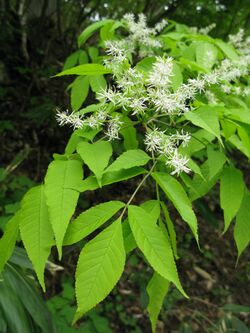Biology:Fraxinus lanuginosa
| Japanese ash アオダモ Aodamo | |
|---|---|

| |
| Scientific classification | |
| Kingdom: | Plantae |
| Clade: | Tracheophytes |
| Clade: | Angiosperms |
| Clade: | Eudicots |
| Clade: | Asterids |
| Order: | Lamiales |
| Family: | Oleaceae |
| Genus: | Fraxinus |
| Section: | Fraxinus sect. Ornus |
| Species: | F. lanuginosa
|
| Binomial name | |
| Fraxinus lanuginosa Koidz.
| |
Fraxinus lanuginosa (Japanese ash; Japanese: アオダモ Aodamo) is a species of ash native to Japan and to the Primorye region of eastern Russia .[1][2]
Fraxinus lanuginosa is a medium-sized deciduous tree growing to 10–15 m tall with a trunk up to 50 cm diameter. The bark is smooth, dark grey. The buds are pale pinkish-brown to grey-brown, with a dense covering of short grey hairs. The leaves are in opposite pairs, pinnate, 10–15 cm long, with 3–7 leaflets; the leaflets are broad ovoid, 4–7 cm long and 2–4 cm broad, downy at the base on the underside, with a finely serrated margin, and short indistinct petiolules. The flowers are produced in panicles after the new leaves appear in late spring, each flower with four slender creamy white petals 5–7 mm long; they are pollinated by insects. The fruit is a slender samara 2–4 cm long and 3–5 mm broad, reddish, ripening brown.[3][4][5][6]
In the population of F. lanuginosa native to central Hokkaidō, northern Japan, "hermaphrodites and males commonly coexist in populations of the species. Hermaphrodites and males have identical flowering phenologies and pollen morphologies".[7]
It is closely related to Fraxinus ornus from Europe and southwest Asia, sharing similar flower characters.[6]
Cultivation and uses
The wood is strong and hard, with a tenacity that allows it to be bent into curves, such as for making tennis rackets and skis.[8] Its wood is also used in the making of baseball bats[9] and electric guitars.[10]
References
- ↑ Kew World Checklist of Selected Plant Families, Fraxinus lanuginosa
- ↑ Gen'ichi Koidzumi. 1926. Botanical Magazine Tokyo 40: 342
- ↑ Aodamo web: Fraxinus lanuginosa (in Japanese; google translation)
- ↑ Japan Trees Guide: Fraxinus lanuginosa (in Japanese; google translation)
- ↑ Hakuba Village: Fraxinus lanuginosa (in Japanese; google translation)
- ↑ 6.0 6.1 Bean, W. J. (1978). Trees and Shrubs Hardy in the British Isles 8th ed., vol. 2. John Murray ISBN:0-7195-2256-0.
- ↑ Kiyoshi Ishida & Tsutom Hiura (1998). Guest Pollen Fertility and Flowering Phenology in an Androdioecious Tree, Fraxinus lanuginosa (Oleaceae), in Hokkaido, Japan. International Journal of Plant Sciences 159: 941–947.
- ↑ Nishikawa, Takaaki; Koizumi, Akio (2016) (in ja). Shurui·Tokucho kara zaishitsu·yoto made wakaru juki to mokuzai no zukan. Sogensha. p. 8. ISBN 978-4422440064.
- ↑ Muto Goichi, Koizumi Akio, Hirai Takuro (2005) Mechanical characteristics of aodamo (Fraxinus lanuginosa) as baseball bats. Nihon Kikai Gakkai Sekkei Kogaku, Shisutemu Bumon Koenkai Koen Ronbunshu 15 304-05 [1]
- ↑ Guitar Wood Types & Tones FAQ
External links
- Peter B. Kitin, Tomoyuki Fujii, Hisashi Abe and Ryo Funada (2004). Anatomy of the vessel network within and between tree rings of Fraxinus lanuginosa (Oleaceae). American Journal of Botany 91: 779–788. Available online
- Henriette's Herbal Homepage, photo Fraxinus lanuginosa
Wikidata ☰ Q1147634 entry
 |

